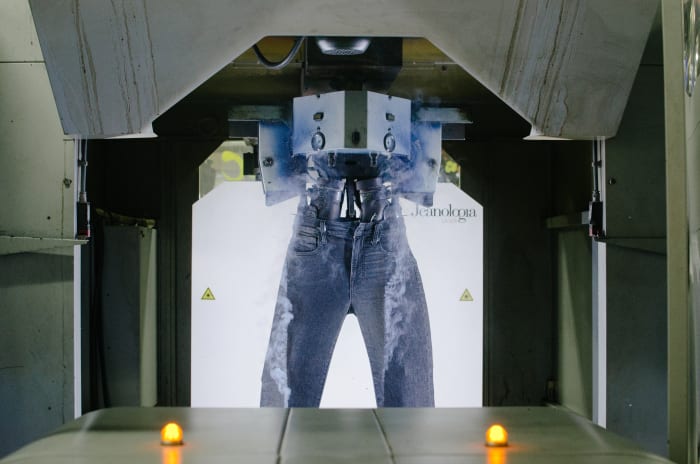
interior Saitex, laser know-how is used to create a worn-in seem on a pair of jeans with minimal environmental have an effect on. image: Whitney Bauck/Fashionista
Welcome to our sequence factory Tour, where we take you inner the manufactu ring facilities of a few of our favorite manufacturers to find out how the outfits we buy are basically made. subsequent up: Saitex, an innovative, sustainability-concentrated manufacturing unit that produces denim for manufacturers like Everlane and Madewell.
if you are going to produce new apparel in an era it truly is seen varied nations declare a state of emergency due to local weather breakdown, you'll better be doing every little thing for your vigor to minimize your have an effect on on the environment. considering that most brands do not personal their own manufacturing facilities, that ability partnering with a manufacturing facility frequent for sustainable production — of which Saitex is a top rate illustration.
Thanks for gazing!talk over with web pageobserved in Vietnam, Saitex is the denim companion of alternative for a host of labels together with ethical favorites like Everlane, Eileen Fisher and G-star raw, apart from Madewell, J.Crew, gap, Tommy Hilfiger, Outerknown, American Eagle, Ralph Lauren, Calvin Klein denims and greater. in-built 2012, Saitex's current amenities had been founder Sanjeev Bahl's response to the human rights and environmental injustices he encountered over a decade of global denim sourcing.
Thanks for observing!visit WebsiteThanks for looking at!seek advice from web sitelinked Articles'Riverblue' Proves just How a great deal trend pollution Hurts the Planet — and Its Inhabitantscan we actually need from now on Sustainable fashion brands?inner a worldwide elegance manufacturer's Mission to invest in the workers Who Make Plastic Recycling possible
"He saw contemporary slavery and lots of environmental hurt," explains Saitex's Sustainability task supervisor Virginia Rollando once I visit the power backyard Ho Chi Minh metropolis. "it truly is why he determined to do his personal thing and set up his personal manufacturing unit."
because its founding, Saitex has grown to accommodate five diverse facilities and now employs over four,500 americans and produces 20,000 pairs of denims a day. along the way, or not it's collected a prolonged checklist of ethics-centric certifications: fair change, very well-Tex, LEED, Bluesign, the Higg Index and B Corp have all given Saitex their stamp of approval.
it's Saitex's imaginative, expertise-ahead approach to sustainability it really is ended in it being described by means of partners like Everlane as "the world's cleanest denim manufacturing facility." study on to get an interior study how it's achieved this — and how it's carrying on with to conform.
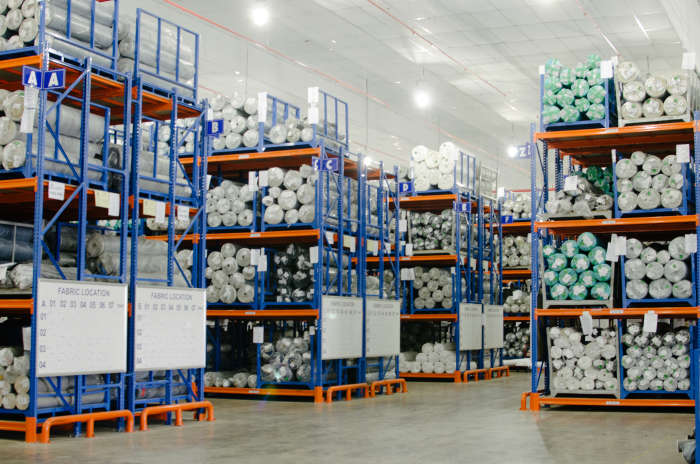
inner the Saitex fabric warehouse. image: Whitney Bauck/Fashionista
Saitex stores 5 million meters of material during this warehouse, all of to be able to ultimately be made into jeans, denim jackets and more. for the time being, fabric is introduced in from outside mills, however Saitex is currently in the system of constructing its personal mill.
"when you do a lifecycle evaluation of a garment — examining all its affects in distinct phases from raw cloth extraction to end of use — you'll observe that a lot of the worst affect is in fiber and textile construction," Rollando explains. "So despite the fact that we tried truly hard to make Saitex sustainable, garments made right here may nevertheless be now not sustainable at all as a result of there were so many steps earlier in the provide chain the place we didn't have any resolution vigor."
The Saitex mill, which should still be up and operating via 2020, is being developed to LEED requisites and will be "entirely covered in solar panels" that should be used to vigor the machinery. 6,000 timber are being planted within the adjoining lot to offset the plant's carbon emissions, and Rollando hopes that by using designing cloth without delay with brands, Saitex should be able to lower excessive textile completing methods that can be harmful to the ambiance.
perhaps most enjoyable from a company point of view, the mill will haven't any minimums, which is frequently an enormous barrier for small labels that don't need to order colossal runs of cloth.

Denim rolls waiting to be reduce and sewn. photo: Whitney Bauck/Fashionista
Saitex proprietor Bahl has also invested in Fibertrace, a technology that creates material that can also be scanned — no hangtag required — to demonstrate tips about who farmed the cotton or sewed the piece. even though it was in the beginning developed as a way to fight luxurious counterfeiting, Bahl is happy in regards to the prospect of the usage of Fibertrace in collaboration with a carbon-high quality farm in Australia to make information about giv e chains completely traceable and accessible to curious valued clientele.
"it be really going to be revolutionary. One difficulty in sustainability is that so a great deal assistance is misplaced," says Rollando. "This technology works with pigments and minerals you discover in financial institution notes and with a scan, you could become aware of these pigments within the fiber. they're inserted in the ginning system of the cotton. so you can be able to scan your garment and get the entire tips concerning the materials, the place the cotton comes from, is it fair exchange, is it B Corp."
All of that's sooner or later for now, as it's no longer yet commercially accessible in pieces that come out of Saitex. but it's only one of the techniques Saitex is working to expand its sustainability cred.
For now, notwithstanding, Saitex works with an entire latitude of normal denim. earlier than the fabric within the warehouse may also be reduce and sewn into clothes, it go es throughout the "relaxer," a computer that unspools the material so it's now not stretched out of form when it's reduce. (although the laptop earned its name due to the impact it has on the denim, staring at the denim pile up in these folds is hypnotic in a means that's fairly enjoyable for any onlooking people, too.) After it be unspooled, the textile is left to relaxation for slightly before it moves onto the factory flooring.
once material has been relaxed, it's able to be cut. There are a few different ways this may turn up: Some items will be reduce through hand by using Saitex employees who lay paper patterns over the top of the denim, others can be cut through machines that are pre-programmed and may reduce through many items of cloth at once.
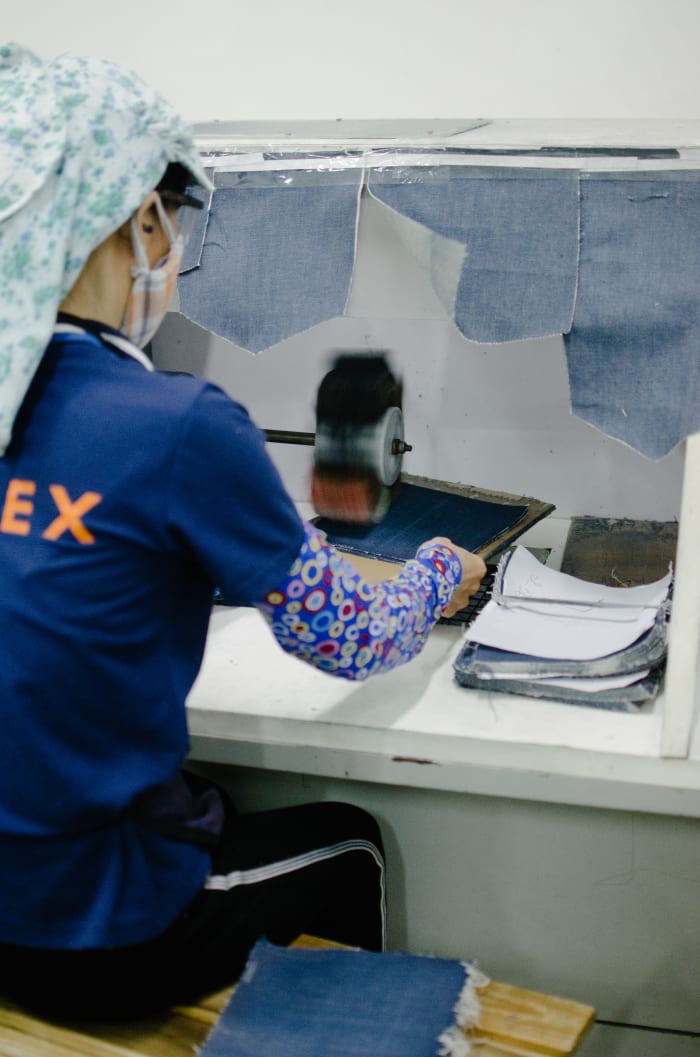
A Saitex employee in my view distressing items of material in an effort to become pockets. photo: Whitney Bauck/Fashionista
though some fabrics can flow straight from being reduce to being sewn, patch pockets may additionally require particular steps.
there may be loads of work that goes into giving your jeans a worn-in look before you purchase them, and if the manufacturing unit is using manual abrasion to accomplish that seem to be, then material as a way to become an outside pocket has to be pre-ground earlier than it be sewn onto the b ack of your jeans. in any other case, the grinding system might wear down the stitches affixing the pocket to the garment.
earlier than they're sewn onto pants, pockets may also also be pre-embroidered (consider of the standard V-shape frequently found on again pockets). right here, one Saitex worker units up a machine that may immediately embroider a whole set of pockets without delay, whereas another screenprints a logo onto items of material which will at last be sewn into clothes.
after all the components are comprehensive, the items of denim are able to be sewn collectively. Like many elements of creation at Saitex, sewing is accomplished via a mixture of human and desktop vigor. really good machines carry elevated efficiency and accuracy to the desk, but they still require professional people to operate them and software them afresh for each and every new trend.
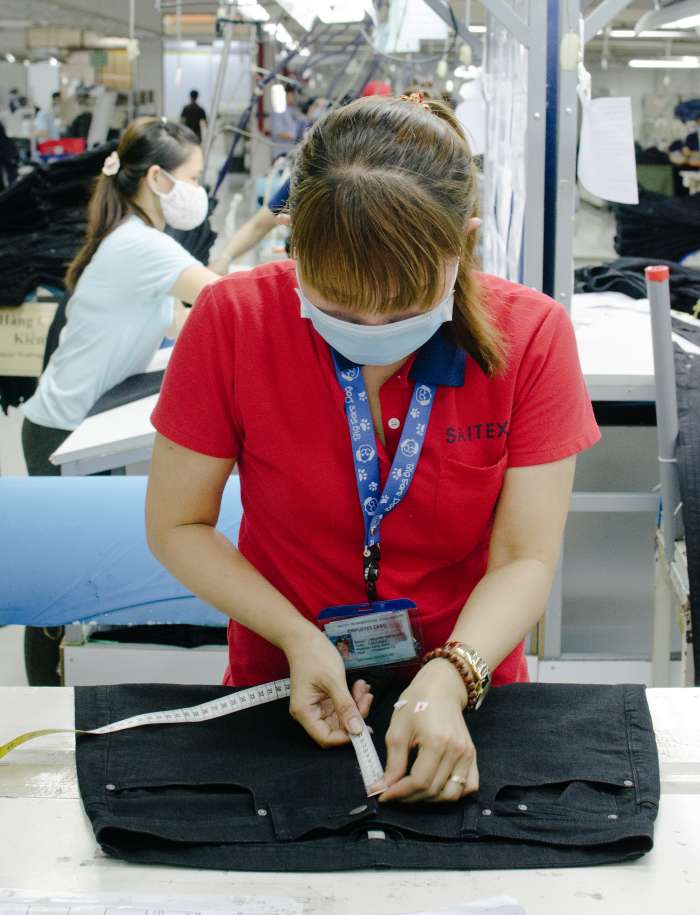
A Saitex worker making first-class manage checks. picture: Whitney Bauck/Fashionista
One job that nonetheless requires a human eye is first-rate control. every piece that passes throughout the Saitex ground is cautiously measured to be sure that sizing and proportions are constant and match what turned into requested for by using the manufacturer. right here, a Saitex employee uses a measuring tape to make certain the relevant dimensions were carried out all through the sewing procedure.
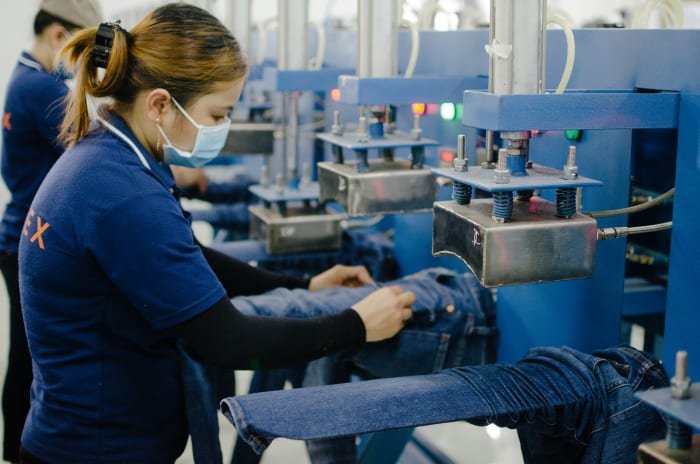
The metal blocks on the top of this desktop observe heat and drive to achieve a worn-in appear. photograph: Whitney Bauck/Fashionista
After denims are sewn and pass via pleasant handle, they're able to be handled and comprehensive. This a part of the technique looks wildly distinc tive depending on the trend — some brand companions are looking to deliver valued clientele jeans that appear so worn they can be old, whereas others may pick out fewer finishing procedures.
right here, an employee bunches denims up on a computer that creates the creases discovered behind the knee via applying heat and power to the wrinkles the employee created.
There are a couple of different ways to melt and fade denim to obtain the worn-in appear that so many brands ask for. Stone washing comprises tumbling jeans with natural pumice stones, which makes use of manual abrasion to soften and fade the jeans. A chemical referred to as potassium permanganate can even be sprayed onto the denim without delay to create a "native bleaching" effect for when a company simplest desires to lighten definite elements of the jeans.
both strategies have environmental pitfalls: stone-washing leaves particles of stone behind on the denim, which then requires extra water to remove and pollutes the water it lingers in; potassium permanganate is toxic in high doses and may be saved out of waterways. but given that some groups demand these tactics because of the seem they obtain on denim, Saitex hasn't completely phased them out. in its place, or not it's tried to reduce their affect.
all of it comes all the way down to water. Saitex uses an ETP (Effluent treatment Plant) device for cleansing the water that passes via its amenities. The device combines reverse osmosis, bacteria nanofiltration and evaporation that cleans water so thoroughly that it can be totally reused in a closed-loop system. (notwithstanding founder Bahl wasn't existing for my consult with, he is famously willing to drink the water after it passes via this filtration equipment to show how clear it is.) Two % of Saitex's water is misplaced through evaporation, but each other drop of it may also be reused.
"This filtration system become a massive investment in 2012," says Rollando. "however was paid returned in 5 years and now it be a supply of rate reductions, as a result of we barely have any water bills."
She's quick to notice, too, that Saitex has the handiest Bluesign-certified laundry on the earth, a further testomony to the way it's fighting toxicity. all the warmth and steam within the laundry are created the use of biomass waste material from the furniture or agriculture industries, so that Saitex would not ought to count on fossil fuels or gas for power. And denims are hung out to air-dry — a seeming no-brainer that's nearly exceptional within the business — to retailer much more energy.
apart from trying to lower the affect of the business's ordinary strategies, Saitex has additionally invested in next-era expertise that may create the look of wear with a tons lower environmental influence. Jeanologia know-how uses lasers to eradicate a best layer of indigo pigment from the excellent of the jeans, whereas Ozone permits for bleaching devoid of the use of any water in any respect.
Saitex also has machines that can function manual sanding and grinding, taking over work it really is under pleasing for people. americans are nonetheless needed to train the machines a way to sand every new vogue, which means that their jobs are not being totally eradicated, but they're required to do less of the actual labor.
in the meanwhile, Saitex's ground features a mixture of all of the above — stone washing and Ozone, laser expertise and chemical bleaching, human and machine-run sanding — however the goal is always to offer further and further sustainable options in order that it be less difficult for manufacturers to make the switch.
there may be a relentless tension for th e Saitex crew between trying to push for sustainable measures and trying to go away the door open for manufacturers that are not all the means there yet.
Case in point: the ability has a no single-use plastic rule for its body of workers and personnel, and everybody is encouraged to carry their personal reusable containers and water bottles. however many agencies nevertheless require that Saitex wrap their jeans for my part in plastic polybags. it's not the most reliable, says Rollando, but on the conclusion of the day she hopes that Saitex can help lead brands into greater sustainable alternate options through advocating for stronger options.

all the furnishings pictured became made the use of tiles made from historical denim and cloth waste. photograph: Whitney Bauck/Fashionista
like every sustainability-centric vogue enterprise price its salt, Saitex has caught onto the buzz round circularity and is trying to take greater responsibility for the items it creates after they've outlived their initial intention. Bahl has invested in Atelier & Repairs , a company committed to upcycling clothing, to try and extend the lifetime of any garment that comes out of Saitex. during the past Saitex has also collaborated with manufacturers like Puma to create shoes made from denim scraps.
Saitex's founder is also developing a manufacturing facility in Thailand so as to create tiles from textile waste that can be utilized in furnishings and ground. in contrast to some similar items, the tiles are made the use of a binder that has hardly ever any petroleum-primarily based product in it, holding the environmental affect at a minimal. up to now, the tiles were used to create a facade for a Christian Louboutin save and to make furniture within the Saitex places of work.
"The intention is to empty landfills, cut back incineration of textile and in the reduction of deforestation because this can substitute wood," Rollando explains.

A greenhouse beneath construction on the Saitex campus. image: Whitney Bauck/Fashionista
though plenty of what Saitex is frequent for is its environmental recognition, it be additionally made treating people well a significant part of its approach of doing company. The campus points a greenhouse and hydroponic crates to grow clean meals for personnel, the enterprise has raised money to con struct orphanages in the area and its fair change certification serves as an assurance to buyers that or not it's paying respectable wages and making certain personnel have a voice in their workplace. part of the motive Bahl selected to start Saitex in Vietnam is that he became impressed with the manner the culture respects girls, and he is proud that women are well-represented in Saitex's management, not simply on its manufacturing unit flooring.
And this manufacturing facility is only the beginning. besides the fabric mill and cloth waste tile factory, Saitex is also preparing to open yet another manufacturing unit in la this fall, which might be used to help American manufacturers very straight away sample smaller batches of items before ordering large runs from the Vietnam factory.
If it feels like Bahl is constructing an empire, it's as a result of he's. for those who suppose the neatest thing for the ambiance can be to shut down the whole trend business the next day, that may now not be first rate information. however for people who want to see sustainable factory alternatives made greater accessible — and appealing — to brands of all sizes, it be a reason to celebrate.
"The intention is to have the most sustainable know-how accessible," Rollando says.
No comments:
Post a Comment